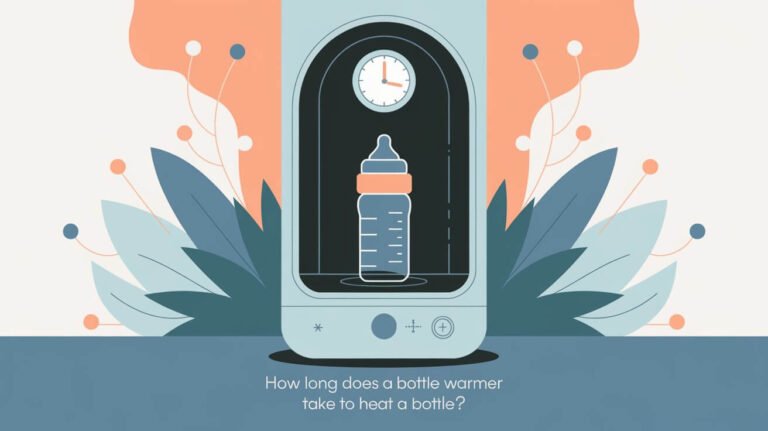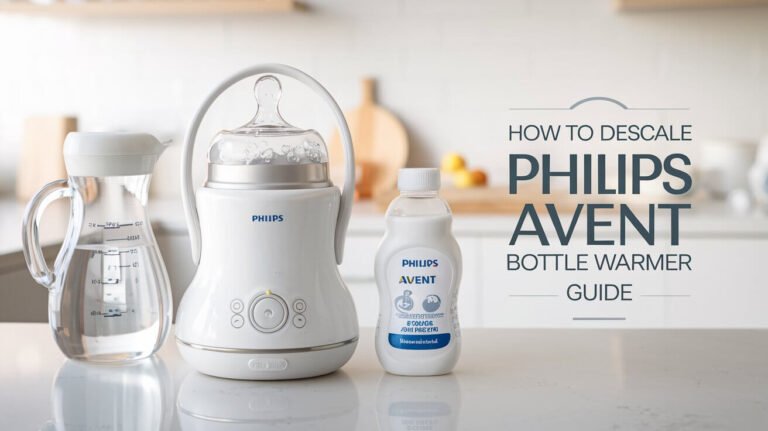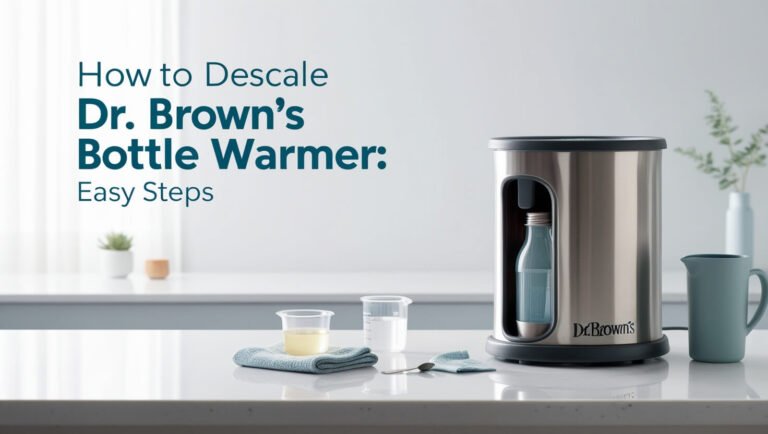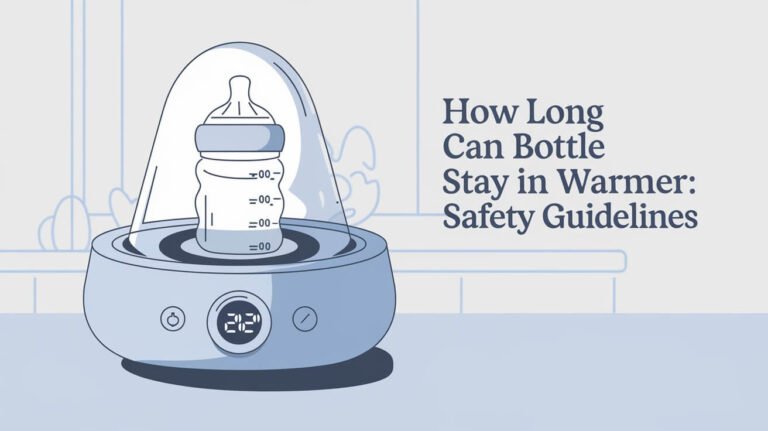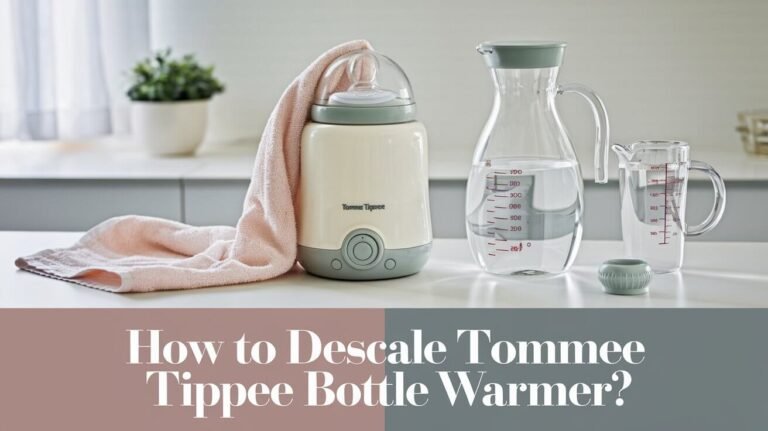What Is a Bottle Warmer: An Essential Tool for Baby Feeding
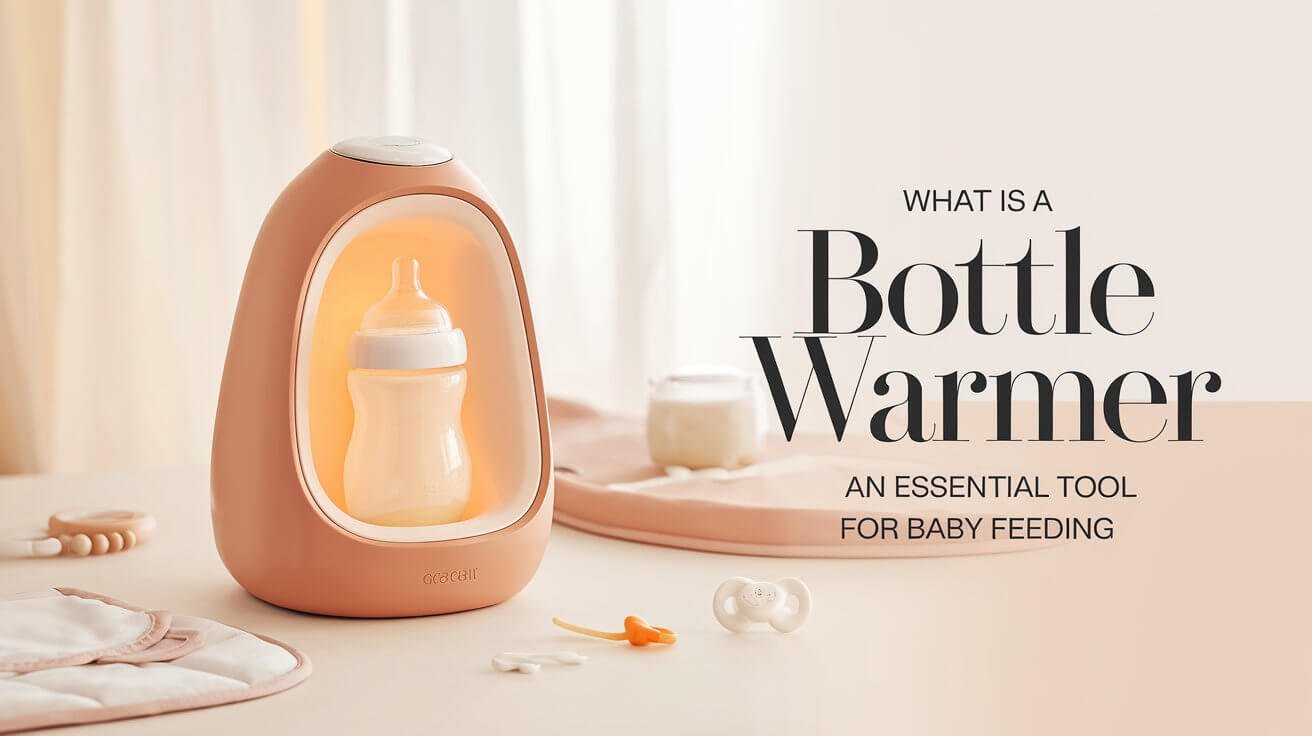
As a new parent, you might wonder, “What is a bottle warmer, and how can it help my baby?” A bottle warmer is a small device that heats up breast milk, formula, or food jars. It uses steam or hot water to warm bottles safely and evenly. This helps keep nutrients in and prevents burns on your baby’s skin.
Bottle warmers come in different sizes and can handle various bottles. They have different warming settings for your baby’s needs. These tools make feeding time easier, whether it’s during the night or when you’re in a hurry. But what makes a bottle warmer special, and why should you get one? Let’s dive into the world of bottle warmers and see how they can benefit your baby’s care.
What Is a Bottle Warmer
A bottle warmer is a handy device for heating baby bottles. It makes sure the formula or breast milk is just right for feeding. It uses special heating tech to warm the liquid safely and easily, unlike using hot water or the stove.
Functions and Basic Components
Bottle warmers do a simple but key job – they warm baby bottles to a comfy drinking temp. They have a warming spot, controls for temperature, and sometimes a timer. This lets parents set the perfect temp, usually between 98-104°F.
Types of Heating Technologies
Bottle warmers mainly use water bath or steam heat. Water bath warmers use warm water to gently heat the bottle. On the other hand, steam heat warmers use steam to heat bottles faster but might not keep the temp steady.
Safety Features and Controls
Keeping bottle warming safe is very important. Many warmers have features like automatic shut-off to stop overheating. They also have special settings for different milk or formula temps. These features help keep the heating just right and make parents feel more at ease.
| Heating Technology | Heating Speed | Temperature Consistency | Examples |
|---|---|---|---|
| Water Bath | Slower | More Consistent | Chicco Digital Bottle Warmer & Sterilizer |
| Steam Heat | Faster | Potential for Variations | Baby Brezza Bottle Warmer |
Benefits of Using Bottle Warmers for Baby Care
Bottle warmers are great for parents and babies. They save time, keep nutrients in breast milk, and are safe. They’re perfect for nighttime or when you’re out.
They save a lot of time. A study found bottle warmers can warm bottles 2.5 minutes faster than boiling water. This is a big help for busy parents, like during late-night feedings.
Bottle warmers also keep breast milk’s nutrients safe. Unlike microwaving, which can harm the milk, warmers heat it gently. The Chicco Digital Bottle Warmer & Sterilizer heats it below 104 degrees Fahrenheit, keeping it nutritious.
They’re also safe. The CDC warns against microwaving baby food because it can burn their mouths. Bottle warmers have automatic shut-off and temperature controls to avoid this.
Portable bottle warmers are great for families on the go. They’re small and light, making it easy to warm up meals anywhere. This adds comfort and convenience to feeding time.
Bottle warmers also help with the switch from breastfeeding to bottle-feeding. Babies who like their milk warm may find bottle-feeding easier. This makes the transition smoother for both parents and babies.
Features like timers and memory functions make bottle warmers even better. The Chicco Digital Bottle Warmer & Sterilizer has dual warming modes. These options give parents more control and customization.
Types of Bottle Warmers on the Market
There are many bottle warmers to choose from to heat your baby’s bottle. Each has its own benefits like speed, consistency, and ease of use. Let’s look at the main types of bottle warmers:
Water Bath Warmers
Water bath bottle warmers use water circulation to warm the bottle. This method keeps the temperature even, ensuring the milk or formula is just right. They are safe and reliable, making them a favorite among parents.
Steam Heat Warmers
Steam heat bottle warmers use steam to quickly warm the bottle. This method is faster but might not be as consistent. They are best for parents who need to warm bottles fast.
Travel Bottle Warmers
Travel bottle warmers are great for parents always on the move. They are small and portable, keeping your baby’s meal warm anywhere. They might not be as precise as others, but they’re handy for feeding on the go.
Choosing the right bottle warmer depends on your needs and lifestyle. Think about speed, consistency, and portability to find the best one for your family.
Safety Guidelines and Temperature Control
Keeping your baby safe is key when using a bottle warmer. Overheating breast milk can lose its nutrients. So, it’s important to keep the temperature right. Try to warm the milk to body temperature (around 98.6°F or 37°C) or a bit lower. Never let it go above 104°F (40°C).
Don’t use a microwave to heat bottles. It can cause hot spots and uneven warming, which might scald your baby. Instead, choose bottle warmers with automatic shut-off and precise temperature controls. This helps prevent overheating. Always check the milk’s temperature before feeding to make sure it’s safe and comfortable for your baby.
| Proper Bottle Warming Guidelines |
|---|
| Avoid overheating breast milk above 104°F (40°C) Aim for body temperature (98.6°F/37°C) or slightly lower Never use a microwave oven to heat bottles Look for warmers with automatic shut-off and temperature settings Always test milk temperature before feeding |
By following these safety guidelines and temperature control measures, you can ensure your baby’s bottle is warmed to the perfect temperature. This preserves the nutrients in breast milk and provides a comfortable and safe feeding experience.
Essential Features to Consider Before Purchase
Choosing the right bottle warmer for your baby involves looking at a few key things. The speed and evenness of warming, how well it fits different bottle sizes, and how easy it is to clean are all important. These factors can greatly affect your daily routine.
Warming Speed and Consistency
Speed and consistency are key when warming bottles. You want a model that heats up milk or formula quickly and keeps it at the right temperature. The BisbeeBaby Keddle is known for warming bottles twice as fast as others, making it a great choice for parents on the go.
Bottle Size Compatibility
It’s important for a bottle warmer to fit different bottle sizes and materials. Being able to warm both standard and wide-neck bottles is a big plus. This means you won’t need to buy multiple warmers as your baby grows.
Cleaning and Maintenance Requirements
How easy a bottle warmer is to clean is a big consideration. Look for one that’s easy to clean and dry to avoid bacteria buildup. Some models even have alerts to remind you when it’s time for a deep clean, making upkeep simple for busy parents.
| Bottle Warmer | Warming Speed | Bottle Compatibility | Cleaning Ease |
|---|---|---|---|
| BisbeeBaby Keddle | 2x faster than others | Fits various bottle sizes and materials | Easy to clean, with notification alerts |
| Philips Avent Premium Fast | Warms 3 oz in under 4 minutes | Fits most standard and wide-neck bottles | Straightforward cleaning process |
| The First Years Gentle Warmth | Warms quickly, priced affordably | Accommodates most bottle types | Simple to clean, with removable parts |
By thinking about these important features, you can find a bottle warmer that meets your needs. It will make feeding time easier for both you and your baby.
Breast Milk Warming Considerations
Properly warming breast milk is key for your baby’s health. It’s a special liquid that needs careful handling to keep its nutrients. Heating it too high can damage these important compounds.
Using water bath warmers is a good way to warm breast milk. They heat it to the right temperature, around 98-105°F (37-41°C). This keeps the milk full of nutrients like folate and probiotics.
It’s important to store and warm breast milk correctly. Only warm what you need for one feeding. This keeps the milk fresh. Some bottle warmers have special settings for breast milk, making sure it’s always the right temperature.
- The ideal temperature range to feed baby milk is between 32 to 78°F (0 to 26°C), though this may not be optimal for baby’s digestion or taste preferences.
- Warming breast milk to around 98.6°F (37°C) closely matches the average body temperature and helps retain the milk’s nutritional qualities.
- Heating breast milk within the range of 99-105°F (37-41°C) is considered lukewarm and safe, without compromising the nutrients.
- Overheating breast milk beyond 106°F (41°C) is not recommended, as it can burn the baby’s mouth and degrade the quality of the breast milk.
Using the right tools ensures your baby gets the best nourishment from breast milk.
Proper Usage and Maintenance Tips
Keeping your bottle warmer in good shape is key. Regular cleaning and descaling are musts. They help your device work well and keep your baby’s feedings safe and clean.
Daily Cleaning Procedures
Always wipe down your bottle warmer after each use. This stops bacteria and bad smells from building up. Use a soft cloth and mild soap to clean it inside and out.
Make sure everything is dry before putting it back together. This helps prevent any damage.
Descaling and Deep Cleaning
Hard water can clog your bottle warmer. You’ll need to descale it sometimes. Use vinegar or a special solution to do this, as the maker suggests.
Deep clean your warmer every few months. Take it apart and clean every part. This keeps it working great.
| Cleaning Task | Frequency | Recommended Procedure |
|---|---|---|
| Daily Cleaning | After Each Use | Wipe down surfaces with a soft, damp cloth and mild detergent. Dry all components thoroughly. |
| Descaling | As Needed (Depending on Water Hardness) | Follow manufacturer instructions for using a vinegar or commercial descaling solution. |
| Deep Cleaning | Every Few Months | Disassemble the warmer, remove any detachable parts, and clean all components thoroughly. Reassemble according to instructions. |
By sticking to these easy bottle warmer cleaning and maintenance tips, your device will stay in top shape. It will keep heating your baby’s bottles safely and efficiently.
Common Mistakes to Avoid
Using a bottle warmer can be tricky. It’s important to know the mistakes that can harm your baby. These include overheating the milk and not cleaning the warmer often.
One big mistake is overheating the milk. This can cause burns and scalds on your baby’s mouth and throat. The NHS warns that bottle feeding mistakes can lead to overfeeding, diarrhea, and more.
- Avoid using the microwave, stove, or boiling water to warm breast milk. These methods can destroy nutrients and create hot spots.
- Warming breast milk the wrong way can reduce its nutritional value and harm your baby.
- Elhée bottles are eco-friendly and safe from overheating, making them convenient for warming breast milk.
Another mistake is not mixing the warmed milk well. This can cause some parts to be too hot and others too cold. Always check the milk’s temperature before feeding and follow the instructions carefully.
Not cleaning and maintaining the bottle warmer regularly is another mistake. 1 out of 5 parents don’t sterilize feeding supplies properly, leading to bacterial growth. Keeping up with cleaning is key to maintaining your bottle warmer’s performance.
| Mistake | Potential Consequences |
|---|---|
| Overheating milk | Burns, scalds, increased risk of overfeeding, diarrhea, indigestion, and vomiting |
| Uneven warming of milk | Hot spots, inconsistent temperature, discomfort for the baby |
| Neglecting cleaning and maintenance | Bacterial growth, contamination, reduced efficiency of the bottle warmer |
By avoiding these mistakes and following the instructions, you can ensure a safe and efficient bottle-warming experience for your baby. Always put your baby’s health and comfort first.
In Closing
Bottle warmers are great for parents, making meal prep easier and safer. They keep nutrients in breast milk and make feeding comfy for babies. They’re not a must-have, but many parents find them helpful, saving time, and making feeding easier, day or night.
These devices warm milk or formula fast and safely. They have features like quick heating, exact temperature control, and turn off on their own. This means your baby’s food is always just right, without being too hot.
Whether you breastfeed or use formula, the right bottle warmer is a big help. It’s a key part of your parenting essentials and feeding solutions.
When looking at bottle warmers, focus on safety, how well they work, and what they offer. A good bottle warmer means your baby always gets their food at the best temperature. It’s a smart choice for any parent.
Simple Questions:
What is a bottle warmer?
A bottle warmer is a small appliance that heats up breast milk, formula, or food jars. It uses steam or hot water to warm bottles evenly. This helps keep nutrients safe and prevents hot spots.
How do bottle warmers work?
Bottle warmers use either water bath or steam heat. Water bath warmers gently warm bottles with circulating warm water. Steam heat warmers warm bottles faster with steam, but might have temperature variations.
What are the benefits of using a bottle warmer?
Bottle warmers save time and warm bottles consistently. They help keep nutrients in breast milk safe. They also ensure safety by avoiding hot spots. Plus, they’re convenient for night feeds or travel.
What are the different types of bottle warmers?
There are two main types: water bath and steam heat warmers. Water bath warmers gently heat with warm water. Steam heat warmers warm faster but might have temperature issues. There are also portable travel bottle warmers for on-the-go feeding.
What safety considerations are important when using a bottle warmer?
When using bottle warmers, safety is key. Avoid heating breast milk above 104°F (40°C) to keep nutrients safe. Some warmers have automatic shut-off and temperature settings. Always check the milk temperature before feeding.
What features should I look for when choosing a bottle warmer?
When picking a bottle warmer, look at warming speed and consistency. Check if it fits different bottle sizes and materials. Also, consider ease of cleaning. Look for features like automatic shut-off, temperature settings, and timer delay. Some warmers have dual warming modes for different types of milk.
How do I properly warm breast milk using a bottle warmer?
Warming breast milk needs care to keep its nutritional value. Use gentle warming methods like water bath warmers. Follow proper storage guidelines for breast milk. Only warm the amount needed to avoid waste. Some warmers have specific settings for breast milk.
How do I clean and maintain a bottle warmer?
Keeping a bottle warmer clean is important for hygiene. Daily cleaning involves wiping down surfaces and removing milk residue. Descaling is needed to remove mineral buildup, which is more common in hard water areas. Follow the manufacturer’s instructions for deep cleaning.
What are some common mistakes to avoid when using a bottle warmer?
Common mistakes include overheating milk and not mixing it well. Avoid using microwaves instead of bottle warmers. Don’t forget to clean and maintain the warmer regularly. Leaving milk in the warmer for too long can cause bacterial growth.

